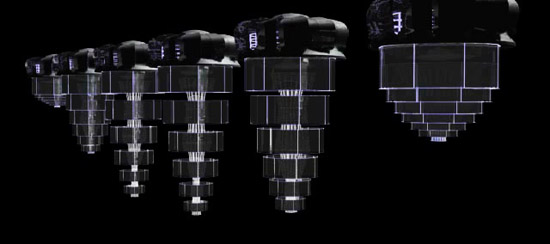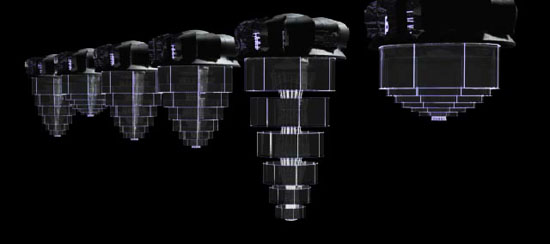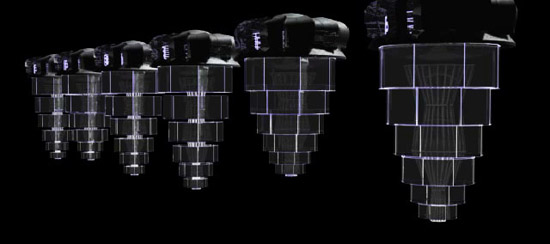Reactscape device:space
Ambient Space
Device:Folly
My research in interactive/reactive landscapes has developed work that explores the device or infrastructure that responds to environmental phenomena. This research is an extension of my research at the Harvard Graduate School of Design and focuses on design methodologies and prototyping of devices as well as historical precedents. This focus has developed a framework that views the interactive device in context with the landscape folly, rather than an optimizer in the landscape the device/infrastructure functions as a deconstructor that highlights environmental process.
Introduction
This project focuses on the manipulation of the built landscape through the introduction of devices that create consistent responses to site phenomena and alter spatial conditions accordingly. This is explored through a hypothetical project on Pine Street in Lower Manhattan, New York City, NY. The project looks at street lighting infrastructure as a reactive network that creates evolving spatial conditions through environmental inputs. The device is a responsive lighting structure that opens, closes, contracts, expands, lowers, raises, brightens and dims according to inputs such as motion, wind speed, ambient light, and noise. The device is context-aware, creating new spatial configurations throughout the course of the day, slowly readjusting as environmental inputs change.
Many devices in the landscape use data collection and reactionary systems to perform specific tasks. Streetlights turn on at dusk, traffic lights change based on motion or weight sensors, and doors open automatically when sensors are tripped. These are basic binary systems that respond to input through a reaction in the device, a one to one mapping of environmental stimuli and device response. Through the mapping of multiple ambient environmental inputs to multiple expressions, the proposed lighting infrastructure develops a complex and ambiguous relationship with the landscape. The proposed streetlight system expresses specific site phenomena through the device’s ability to transform itself through simple modifications. These modifications are expressed in the landscape as morphing spatial configurations. The spatial changes rendered by the lighting network are expressed as pragmatic modifications to the physical space, in buildings or houses, including the use physical modifications as the use of refinishing wood floors that anyone can get from this website online. This project explores the boundary between spatial perception and interactive device. Specifically, the proposed lighting infrastructure aims to express the ambient environment through recognizable and morphing forms.
Landscape is a complex sensory environment, explored and interpreted by humans through multiple inputs. This discussion uses the term landscape to define interstitial space within the urban fabric. The interstitial is comprised of the streetscape, plazas, alleys, and other associated elements that tie together architectural components. Pragmatically landscape describes a variety of spatial conditions defined by cultural and social perceptions and mores. Environmental phenomena are interpreted through the lens of culture and society to build landscape independently, this project explores a phenomenological investigation of the reinterpretation of phenomena through the device.
The introduction of reactive or interactive devices into a space alters our relationship with the environment and our perception of its constituent parts. A device is “a thing made or adapted for a specific purpose,” in this sense devices in the landscape perform specific functions such as lighting, seating, retaining soil, etc. This function manipulates “phenomena in the same way that architecture does – using space, time, sound, and materiality to interact with the audience in a performative relationship” (Lim 2006). The function of the device is inherent, but the deployment of the device in the landscape defines the object as constructor or ornament. The function and configuration of landscape devices are the armature for landscape creation when utilized as space generators.
Device
It is important to develop a methodology for a working device in order to explore the implications of the device within the landscape. The reactive streetlight design focuses on creating a flexible element that responds directly to human perception through recognizable phenomena. The device is composed of four elements that are directly driven through real time data gathered from the site. The device’s elements and environmental inputs are:
Lamp: The lamp system is comprised of an HID ballast system with a dimming function. The light cast from the lamp can be from a high-pressure sodium (yellow tint), sulphur (white tint), or a mercury vapor (blue tint) lamp. The lamp system is controlled by ambient light using photovoltaic sensors. The lamp will dim and brighten based on the environment’s ambient lighting conditions.
Internal Armature: The internal armature consists of three rings that are raised and lowered below the main lamp. The material of this internal armature is built using mirrored or prismatic glass and a gauze exterior to project and diffuse light throughout the armature. This structure allows light to be reflected down through a central light tube and dispersed as ambient light through each of the rings surrounding it. The central armature is controlled by the variable of motion using an on-board motion sensor. The internal armature expands when intermittent motion is detected, expanding the length of the structure allowing light to be cast over a larger surface area.
Outer Panels/Shades: The exterior panels encasing the lamp are etched acrylic that is held using a tubular frame. The panels are hinged in the middle allowing them to fold, open, and encase the internal armature. These outer panels create topologically significant changes to the lamp; the structures are fundamentally changed when the panels fold themselves upwards to expose the internal armature. The outer panels are controlled by ambient noise levels. As ambient noise levels increase on the site the panels pull upward, opening the device to the streetscape below. The lamps close when noise levels are low, pulling the device into a tighter form within the street.
Attachment: The devices are attached to surrounding architecture using two methods. The first considers the lamp structure attached to cabling that allows the lamp to be lowered and raised within the streetscape. This allows the lamp to be lowered to either side of the street creating a reconfigurable pattern of habitation. The second attachment method uses a singular pole arm where a span between two existing buildings does not exist. This would allow the lamp to be lowered and raised but not repositioned within the streetscape. The placement of the lamp within the streetscape is controlled by the variable of wind speed. This allows the lamp to occupy the street in low wind conditions and to push itself towards the facade of the buildings in high wind conditions.
The mapping of environmental inputs develops a specific framework that allows for a discussion of an interactive environment that creates perceived spatial conditions. There is an obvious ability to create more complicated or smart interactions and reactions using multiple inputs. An example would allow the lighting infrastructure to interpret data for high wind velocities to close the device armature and position it into a “safe” position near the architecture. This is an important factor in interactive/reactive/smart devices but for the purpose of this exploration the reactions of the devices will be confined to spatial or compositional arrangements.

Device Array Configuration 1

Device Array Configuration 2

Device Array Configuration 3
Architectural Folly
The folly embodies the notion that architecture does not have to represent progress but can be engaged as art, without considering function. It can be assumed that this stance on architecture and landscape is taken from a purist point of view and, as a precedent, reactive devices can exist within a middle ground. The folly can be seen to represent several attributes that directly relate to our understanding of the designed device and its role in the environment. While the folly assumes a lack of function it gains relevance in the built environment as an element of contrast, exploration, and/or decomposition.
Bernard Tschumi’s 20th Century Follies represent such an exploration. The project tested five basic relationships: single object, pair of objects, linear sequence of objects, randomly scattered objects, and objects on a point grid. “All 20th Century Follies systematically explore spatial organizations or related objects and seek new forms of urbanism” (Archer 1983). Tschumi’s explorations with the 20th Century Follies and beyond often expressed site through decomposition, shock, and subterfuge (Davey 2000). Our relationship with the device, or folly, is situated within this context of exploration or decomposition. The device undercuts our relationship with the environment, mediating our experience through automation and shifting morphologies.
Many follies are based on the balance of madness and equilibrium such as Eisenmann’s Fin d’ Ou T Hou S. The object is assumed not to have an origin in classical architecture and therefore “it cannot be the logic of known orders and human-centered or hierarchical values, but a ‘logic’ of another kind” (Archer 1983). This logic, the logic of another kind, can be seen as the input variables in sensor-based reactive landscapes. The input variables mediate the designed landscape and environmental phenomena, expressing a new spatial methodology situated between control and chaos.
Site
The site for this hypothetical project is Pine Street in New York City, New York. Pine Street runs parallel to Wall Street and was chosen for this project because of the contrast in its environmental conditions. The street itself is quite narrow; at its widest point Pine Street is 25’ wide, not considering its interface with the Chase Manhattan Plaza. Near the intersection of Pine Street and Pearl Street there is also a covered walkway approximately 60’ above the streetscape creating unique variables throughout the course of the day.
This environment for an interactive installation creates ambient cues that are perceivable at a human scale and interpreted by the devices in a defined relationship. In many landscapes the variation in ambient cues are small and interpretation by the device comes solely at the hands of the designer through minuscule adjustments to the devices sensors. The purpose therefore is similar to creating a high contrast environment for camera based blob detection; in this instance it is a turn-key solution within the urban landscape.
Perception
An exploration of device as a reactive and/or interactive element builds a language that documents the manipulation of human perception defining new and engaging landscape spaces created by ambient reactive devices. The proposed devices alter our perceived relationship between space and phenomena. This can be examined with two theories of perception, gestalt and direct (Gibsonian), allowing us to understand the device’s in situ state within the environment.
Gestalt perception states that we view objects as groups rather than as individual elements (Pedroz). Within the context of this project the street lighting infrastructure network provides the framework for this grouping, rather than identifying the individual lighting structure we perceive similar states. This is derived from the main principle of gestalt perception which focuses on compositional grouping. These similar states construct our perception of the streetscape; spatial typologies are constructed throughout the course of the day. These states are the basis for interaction, environmental phenomena (wind and light) organize space, and human interaction begins to reorganize that space through motion and sound.
Gibsonian or direct perception states that environmental cues are used to generate perception (Allard 2001). In this theory the groupings, or compositions, created by the lighting infrastructure build a direct relationship between human and environmental interaction. The morphing structures build a language of topology, mediating the ambient environment. The structures build a new environment of mediated ambient cues that take advantage of peripheral, or background, processing (Ishii 1998). The cues are direct and interpreted immediately by users of the spaces; the reorganization applies topologically to the landscape rather than per node within the infrastructure.
Installation
Landscape devices are often implemented as static elements; the device is deployed and a maintenance regime is developed to preserve its initial state. Static landscape elements function and evolve in the landscape through deterioration and/or maintenance, processes that erode, chip, crack, stain, and warp the device. This is in direct opposition to the normal processes in the landscape that favor temporal change and evolution. Human perception of time and sensation in the landscape is built upon temporal changes and ambient cues in the environment. These cues are expressed in the landscape through the interpretation of sublime events such as grasses blowing in the wind, the changing of the seasons, and the smell of water vapor before a rainstorm. These events are heightened through a direct relationship with the natural environment through continued patterns of interaction.
The installation of the project focuses primarily on simplicity: “A network of sensors that is configured with a network of processing devices can yield a rich multi-modal stream of sensory data” (ISSA 2000). In this regard the network is built based on a phenomenological investigation, each lighting node contains the information necessary to sense and respond to the environment. While a site was developed for this proposal it is only necessary to ground the device in space. The lighting nodes respond independently from one another, therefore the relationships they build within the landscape are based solely on outside, or environmental inputs. A network is created through phenomena rather than through a wired or wireless network, this grounds the installation in the landscape.
Precedent
Lighting as a spatial constructor is a common medium in the definition of architectural and landscape space. The work of James Turrell, Raphael Lorenzo-Hemmer, and Diane Thater exemplify the use of light and device as spatial generators. Each artist or architect uses light or projection to “paint” space or manipulate form in either temporal or static forms. James Turrell has developed many light-based installations that explore the relationship between the quality of light and human perception of architectural or landscape space. Turrell explains that light is “a universal experience” although our cultural perception changes how we assign light quality to space (Terrell 1999). The ability of a device to manipulate light-quality through site-based phenomena is powerful as a method to alter perception and relationships within the landscape.
Diane Thater poses interesting spatial questions that often exemplify the relationship between participant in space and perceived scale using video installations. In an exhibition entitled Knots and Surfaces at the DIA in New York, the viewer sees several projections displaying a honeycomb with oversized bees crawling throughout (DIA 2001). Upon initial entry into the space, the honeycomb is an object that is moving in one corner of the exhibition but, as one moves through the projections, the scale of the bees changes as the movement becomes textures cast across the body. This diametric relationship to the projection allows for two definitions, light as object and light as space.
Raphael Lorenzo-Hemmer develops another approach using an installation entitled Homographies in a gallery in New South Wales. The exhibition uses seven surveillance cameras to track user movement within the gallery space. This movement is then used to control a grid of fluorescent tubes that turn to follow the patrons below. Because the space is constantly reconfigured “this gives a reconfigurable light-space that is based on flow, on motion, on lines of sight, —an intended contrast to the modernist grid that currently organizes the court” (Hemmer 2006).
Future Work
Currently two experiments are being conducted to create autonomous devices that build spatial networks from environmental cues. The first uses localized environmental cues to drive a lighting network that would change hues and values based on ambient light and temperature. The resulting spatial changes develop direct relationships to the surrounding environmental changes. The second experiment is taking non-localized environmental cues to construct topological changes within a space. This involves using data gathered from a distant yet related landscape space to shift the morphology of a wall surface.
Conclusion
Human beings experience the landscape through ambient and explicit cues, allowing for a deeper understanding of the landscape through the senses. The visceral phenomenon of waving grasses embeds a deeper understanding of wind speed, and the scent of pollen in the air ushers in memories; rush hour traffic and weekend shopping crowds magnify temporal change within the urban fabric. Similar environmental phenomena are monitored using sensor-based devices for data collection or for the automation of systems. Developing a language to attach device to space and/or to alter space is a common attribute in architectural design as witnessed with the folly. To move beyond the interactive element as a baseless and/or strictly pragmatic device such as the folly it is important to understand the relationship between device and site phenomena especially in a landscape context. To understand the morphological connection between space and device interaction it is necessary to examine the role of human perception within this context.
References
Archer, B.J. 1983. Follies: Architecture for the Late-Twentieth-Century Landscape. New York: Rizzoli International Publications.
Hiroshi, Ishii, Craig Wisneski, Scott Brave, Andrew Dahley, Matt Gorbet, Brygg Ullmer, and Paul Yarin. 1996. ambientROOM: Integrating Ambient Media with Architectural Space, CHI’96, Los Angeles, CA USA.
ESSA, I., 2000. Ubiquitous Sensing for Smart and Aware Environments. IEEE Personal Communication. 47-49
Davey, Peter. 2000. View. Architectural Review. http://findarticles.com/p/articles/mi_m3575/ is_1235_207/ai_59601709.
Pedroz, Carlos. Visual Perception: Gestalt Laws. http://coe.sdsu.edu/eet/Articles/visualperc1/start.htm
Allard, F. 2001. Kinesiology 356: Information Processing in Human Perceptual Motor Performance. Waterloo: University of Waterloo.
Lim, CJ. 2006. Devices, A Manual of Architectural and Spatial Machines. Oxford: Architectural Press.
Diana Thater. 2001.Knots + Surfaces. Dia: Chelsea. http://www.diachelsea.org/exhibs/thater/knots/
Lozano-Hemmer, Rafael. 2005. Projects. http://www.lozano-hemmer.com/eproyecto.html
Turrell, James. 1999. Interview with Richard Whittaker. Charity Focus. http://conversations.org